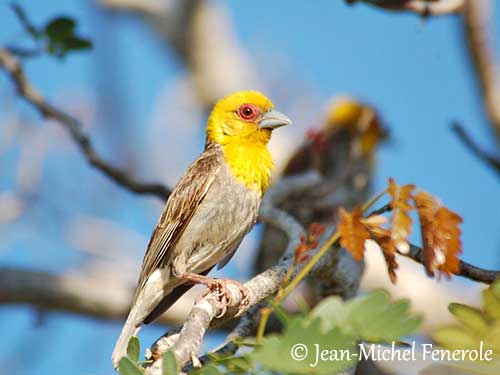
Fr: Tisserin sakalave
Ang: Sakalava Weaver
All: Sakalavaweber
Esp: Tejedor Sakalava
Ita: Tessitore sakalava:
Nd: Sakalavawever
Sd: sakalavavävare
Mal: Draky, Fodibeotse, Fodisahy, Tsiaka, Zaky
Photographers:
John Anderson
John Anderson Photo Galleries
Jean-Claude Billonneau
Photographe-témoin de la Beauté du Monde
Jean Michel Fenerole
Photos d’Oiseaux du monde
William Price
PBase-tereksandpiper & Flickr William Price
Philip Stapelberg
GALLERY
Alan & Ann Tate
AA Bird Photography
Text by Nicole Bouglouan
Sources:
HANDBOOK OF THE BIRDS OF THE WORLD Vol 15 by Josep del Hoyo-Andrew Elliot-David Christie - Lynx Edicions – ISBN: 9788496553682
The Birds of Africa: Volume VIII: The Malagasy Region: Madagascar, Seychelles, Comoros, Mascarenes - Par Roger Safford, Frank Hawkins – ISBN: 1408190494, 9781408190494- Editeur: A&C Black, 2013
Birds of Madagascar and the Indian Ocean Islands Par Roger Safford, Adrian Skerrett, Frank Hawkins – ISBN: 1472924118, 9781472924117- Editeur: Bloomsbury Publishing, 2015
Sakalava Weaver (Ploceus sakalava) nesting association with raptors: An alternative hypothesis
Weaver watch - Monitoring the Weavers of the World
Wikipedia, the free encyclopaedia
Sakalava Weaver
Ploceus sakalava
Passeriformes Order – Ploceidae Family
INTRODUCTION:
The Sakalava Weaver is endemic to Madagascar where it occurs in N, W, SW and S of the island, often in open country, spiny-bush areas and dry deciduous forest. Two subspecies share the range.
Like other Ploceidae, it nests in colonies in tall trees often near villages. Both adults build the hanging nest and share the nesting duties.
The Sakalava Weaver is common throughout the range. They are usually protected by local people and considered as a sign of good fortune.

DESCRIPTION OF THE BIRD:
Biometrics:
Length: 15 cm
Weight: 20-28 g
The Sakalava Weaver adult male in breeding plumage has yellow head to upper breast. On the upperparts, mantle and scapulars have grey-brown feathers with darker centres. They show paler fringes in fresh plumage. The rump is grey.
On the dark brown upperwing, tertials and greater coverts have broad, pale buff fringes, whereas the median-coverts have buffy-white tips forming a narrow, pale wingbar. The flight-feathers have narrow pale edges. The tail is dark brown with narrow, pale edges to rectrices.
On the underparts, lower breast, belly and flanks are grey, but the undertail-coverts are dull white.
The thick bill is silver-blue. The eyes are deep brown, surrounded by bare, reddish eyering. Legs and feet are flesh-coloured.
The adult male in non-breeding plumage has grey head, pale pink eyering and pale grey bill.
The adult female has grey head too, but the lores are paler, mostly greyish-buff. Cheeks and long supercilium are rufous, and the double malar stripe is grey and rusty. She has paler underparts than male, with whitish throat and undertail-coverts, and some buff on body sides.
The juvenile resembles female, but it has paler head and pale horn bill.

SUBSPSCIES AND RANGE:
The Sakalava Weaver has two subspecies.
P.s. sakalava is found in N and W Madagascar.
P.s. minor is found in SW and S Madagascar.
Both races are very similar, but P.s. minor is smaller than nominate.
HABITAT:
The Sakalava Weaver is common in dry areas of N, S and W, and frequents habitats cleared by human settlement, cultivations and regrowth, and also spiny-bush areas and dry deciduous forest.
It is usually seen below 700 metres, sometimes up to 1,000 metres of elevation.

BEHAVIOUR IN THE WILD:
The Sakalava Weaver is mainly granivorous and feeds on small seeds and rice. It also takes regularly insects and spiders, but especially when feeding its young. It also feeds on flowers of genus Alluaudia, an endemic plant species.
Insects are caught from tree branches. The rice is picked up in villages, but this is mainly waste rice.
This species may form flocks that feed on the ground outside breeding season, but it also forages alone.

The Sakalava Weaver is a colonial nester, and the colonies are established from several years and usually regularly reused.
The courtship displays are poorly known. The male frequently courts any passing females, even while feeding the chicks. The displays include drooping and wing-fluttering when the male approaches a female. It sometimes carries nest material that will be added to the nest entrance. The female often escapes into the nest, but the male rarely ventures into the hanging structure. When the nest is almost complete, the female hops towards the male which is fluttering the wings, and she may solicit copulation. Most birds are socially monogamous, but some males are polygynous.
The Sakalava Weaver probably performs local movements after nesting.
The flight is fast with shallow wingbeats.

It is placed between 2 and 25 metres above the ground in tree such as palm or baobab. It can be attached to twigs or suspended by short, woven rope. It may be placed below the large nests of Corvidae or raptors, but also suspended from roofs in villages. During the breeding season, the male sleeps in unoccupied nest while the female remains with the brood.
The female lays 2-4 greenish-blue eggs with scattered small spots. She incubates alone. However, both parents feed the young with insects and spiders. The duration of both incubation and nestling periods is unknown.
The nests are often attacked by Madagascar Harrier-Hawks and lemurs.




